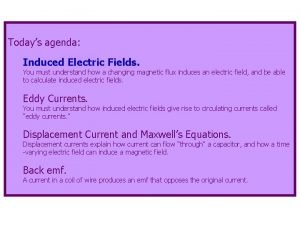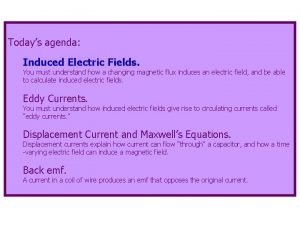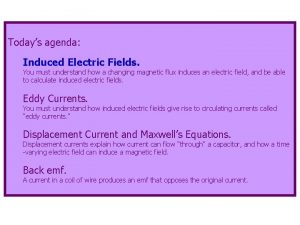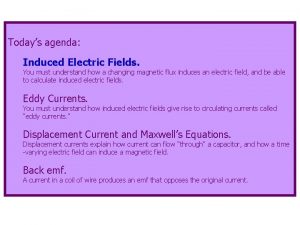Todays agenda Induced Electric Fields You must understand





- Slides: 5

Today’s agenda: Induced Electric Fields. You must understand how a changing magnetic flux induces an electric field, and be able to calculate induced electric fields. Eddy Currents. You must understand how induced electric fields give rise to circulating currents called “eddy currents. ” Displacement Current and Maxwell’s Equations. Displacement currents explain how current can flow “through” a capacitor, and how a time -varying electric field can induce a magnetic field. Back emf. A current in a coil of wire produces an emf that opposes the original current.

Eddy Currents You have seen how a changing magnetic flux can induce a “swirling” current in a conductor (the beginning of this lecture). If a conductor and a magnetic field are in relative motion, the magnetic force on charged particles in the conductor causes circulating currents. These currents are called “eddy currents. ” Eddy currents give rise to magnetic fields that oppose any external change in the magnetic field.

Eddy Currents Eddy currents are useful in generators, microphones, metal detectors, coin recognition systems, electricity meters, and roller coaster brakes (among other things). However, the I 2 R heating from eddy currents causes energy loss, so if you don’t want energy loss, you probably think eddy currents are “bad. ”

Eddy Current Demos cylinders falling through a tube magnetic “guillotine” hopping coil launcher magnetic flasher

Conceptual Example: Induction Stove An ac current in a coil in the stove top produces a changing magnetic field at the bottom of a metal pan. The changing magnetic field gives rise to a current in the bottom of the pan. Because the pan has resistance, the current heats the pan. If the coil in the stove has low resistance it doesn’t get hot but the pan does. An insulator won’t heat up on an induction stove. Remember the controversy about cancer from power lines a few years back? Careful studies showed no harmful effect. Nevertheless, some believe induction stoves are hazardous.







